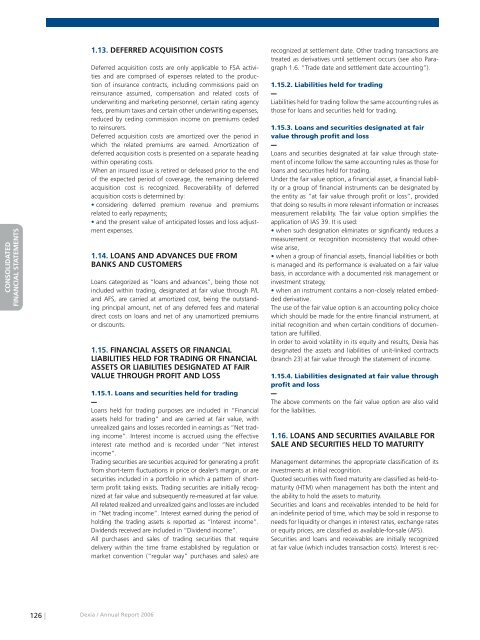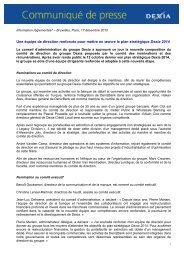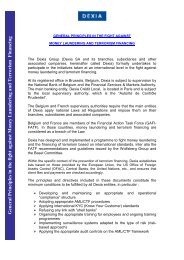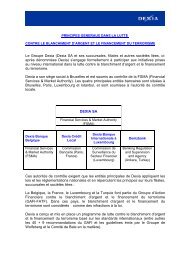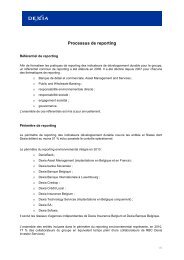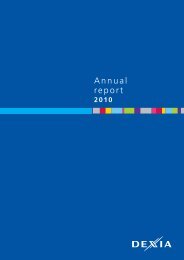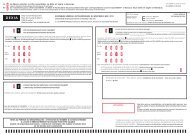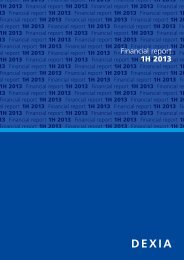Annual report 2006 - Dexia.com
Annual report 2006 - Dexia.com
Annual report 2006 - Dexia.com
You also want an ePaper? Increase the reach of your titles
YUMPU automatically turns print PDFs into web optimized ePapers that Google loves.
RAPPORT DE GESTION<br />
CONSOLIDATED<br />
FINANCIAL STATEMENTS<br />
COMPTES SOCIAUX<br />
1.13. DEFERRED ACQUISITION COSTS<br />
Deferred acquisition costs are only applicable to FSA activities<br />
and are <strong>com</strong>prised of expenses related to the production<br />
of insurance contracts, including <strong>com</strong>missions paid on<br />
reinsurance assumed, <strong>com</strong>pensation and related costs of<br />
underwriting and marketing personnel, certain rating agency<br />
fees, premium taxes and certain other underwriting expenses,<br />
reduced by ceding <strong>com</strong>mission in<strong>com</strong>e on premiums ceded<br />
to reinsurers.<br />
Deferred acquisition costs are amortized over the period in<br />
which the related premiums are earned. Amortization of<br />
deferred acquisition costs is presented on a separate heading<br />
within operating costs.<br />
When an insured issue is retired or defeased prior to the end<br />
of the expected period of coverage, the remaining deferred<br />
acquisition cost is recognized. Recoverability of deferred<br />
acquisition costs is determined by:<br />
• considering deferred premium revenue and premiums<br />
related to early repayments;<br />
• and the present value of anticipated losses and loss adjustment<br />
expenses.<br />
1.14. LOANS AND ADVANCES DUE FROM<br />
BANKS AND CUSTOMERS<br />
Loans categorized as “loans and advances”, being those not<br />
included within trading, designated at fair value through P/L<br />
and AFS, are carried at amortized cost, being the outstanding<br />
principal amount, net of any deferred fees and material<br />
direct costs on loans and net of any unamortized premiums<br />
or discounts.<br />
1.15. FINANCIAL ASSETS OR FINANCIAL<br />
LIABILITIES HELD FOR TRADING OR FINANCIAL<br />
ASSETS OR LIABILITIES DESIGNATED AT FAIR<br />
VALUE THROUGH PROFIT AND LOSS<br />
1.15.1. Loans and securities held for trading<br />
Loans held for trading purposes are included in “Financial<br />
assets held for trading” and are carried at fair value, with<br />
unrealized gains and losses recorded in earnings as “Net trading<br />
in<strong>com</strong>e”. Interest in<strong>com</strong>e is accrued using the effective<br />
interest rate method and is recorded under “Net interest<br />
in<strong>com</strong>e”.<br />
Trading securities are securities acquired for generating a profit<br />
from short-term fluctuations in price or dealer’s margin, or are<br />
securities included in a portfolio in which a pattern of shortterm<br />
profit taking exists. Trading securities are initially recognized<br />
at fair value and subsequently re-measured at fair value.<br />
All related realized and unrealized gains and losses are included<br />
in “Net trading in<strong>com</strong>e”. Interest earned during the period of<br />
holding the trading assets is <strong>report</strong>ed as “Interest in<strong>com</strong>e”.<br />
Dividends received are included in “Dividend in<strong>com</strong>e”.<br />
All purchases and sales of trading securities that require<br />
delivery within the time frame established by regulation or<br />
market convention (“regular way” purchases and sales) are<br />
recognized at settlement date. Other trading transactions are<br />
treated as derivatives until settlement occurs (see also Paragraph<br />
1.6. “Trade date and settlement date accounting”).<br />
1.15.2. Liabilities held for trading<br />
Liabilities held for trading follow the same accounting rules as<br />
those for loans and securities held for trading.<br />
1.15.3. Loans and securities designated at fair<br />
value through profit and loss<br />
Loans and securities designated at fair value through statement<br />
of in<strong>com</strong>e follow the same accounting rules as those for<br />
loans and securities held for trading.<br />
Under the fair value option, a financial asset, a financial liability<br />
or a group of financial instruments can be designated by<br />
the entity as “at fair value through profit or loss”, provided<br />
that doing so results in more relevant information or increases<br />
measurement reliability. The fair value option simplifies the<br />
application of IAS 39. It is used:<br />
• when such designation eliminates or significantly reduces a<br />
measurement or recognition inconsistency that would otherwise<br />
arise,<br />
• when a group of financial assets, financial liabilities or both<br />
is managed and its performance is evaluated on a fair value<br />
basis, in accordance with a documented risk management or<br />
investment strategy,<br />
• when an instrument contains a non-closely related embedded<br />
derivative.<br />
The use of the fair value option is an accounting policy choice<br />
which should be made for the entire financial instrument, at<br />
initial recognition and when certain conditions of documentation<br />
are fulfilled.<br />
In order to avoid volatility in its equity and results, <strong>Dexia</strong> has<br />
designated the assets and liabilities of unit-linked contracts<br />
(branch 23) at fair value through the statement of in<strong>com</strong>e.<br />
1.15.4. Liabilities designated at fair value through<br />
profit and loss<br />
The above <strong>com</strong>ments on the fair value option are also valid<br />
for the liabilities.<br />
1.16. LOANS AND SECURITIES AVAILABLE FOR<br />
SALE AND SECURITIES HELD TO MATURITY<br />
Management determines the appropriate classification of its<br />
investments at initial recognition.<br />
Quoted securities with fixed maturity are classified as held-tomaturity<br />
(HTM) when management has both the intent and<br />
the ability to hold the assets to maturity.<br />
Securities and loans and receivables intended to be held for<br />
an indefinite period of time, which may be sold in response to<br />
needs for liquidity or changes in interest rates, exchange rates<br />
or equity prices, are classified as available-for-sale (AFS).<br />
Securities and loans and receivables are initially recognized<br />
at fair value (which includes transaction costs). Interest is rec-<br />
126 |<br />
<strong>Dexia</strong> / <strong>Annual</strong> Report <strong>2006</strong>


